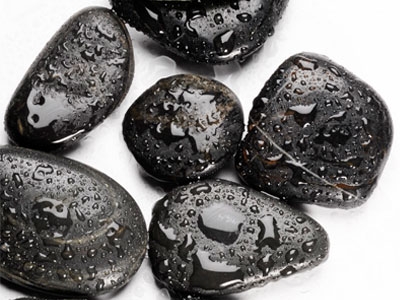Sequence of activities Introduction. Stone surface material may be lost all over or only in spots that are more reactive.
How Does Acid Rain React With Rocks Over Time Quora
Through oxidation reactions iron-rich materials transform in the presence of oxygen in the air.
. CaCO 3 H 2 SO 4 CaSO 4 H 2 O CO 2 The formation of calcium sulphate. CO 32- 2H - H 2 O CO 2. Hydrolysis takes place when acid rain reacts with rock-forming minerals such as feldspar to produce soluble minerals that are removed in solution.
The acidic water kills aquatic and organisms like planktons and fishes disturbing ecosystem. When sulfurous sulfuric and nitric acids in polluted air and rain react with the calcite in marble and limestone the calcite dissolves. The Effects of Acid Rain on Rocks and Minerals What is Acid Rain.
Acid rain has the following reaction with the marble calcium carbonate. It began at the zenith of the industrial revolution. The weathering of rocks by chemicals is called chemical weathering.
Fes H 2 SO 4 aq FeSO 4 aq H 2 g CaCO 3 s H 2 SO 4 aq CaSO 4 s CO 2 g H 2 Ol Water pollution. Over broad regional scales and in locations far from the sources of emissions. Rainwater is naturally slightly acidic because carbon dioxide from the air dissolves in it.
Weathering from Acid Rain. When acidic rainwater falls on limestone or chalk a chemical reaction happens. When rocks and minerals are altered by hydrolysis acids may be produced.
Limestone is calcium carbonate CaCO 3. Calcium-based minerals such as marble and limestone are particularly vulnerable. Softer less resistant rocks wear away at a faster rate than more weather resistant rocks.
The effect of acids on minerals is an example of solution weathering. When the acid rain touches the rock it starts to break down the molecules in the rock causing cracks to appear leading to bits falling of. However carbonate rocks such as limestone and marble can be noticeably affected by acid rain because they predominantly contain calcium carbonate which is far more reactive to acid attack than.
Igneous and metamorphic rocks exposed to acid rain can. PH is a scale that measures how acidic or basic a chemical is and ranges from 0-14 with 7 being neutral below 7 acidic and above 7 basic. These dissolve in the water and then are washed away.
Acid rain slowly dissolves rocks due to chemical reactions between the acid and the minerals in the rock. HOPE IT HELPS PLEASE MARK IT THE BRAINLIEST. The effect of acid rain on most rocks is insignificant since the majority of rocks making up the Earths crust 92 are silicate-based and dont readily react with even strong acids.
How Does Acid Rain Occur. The acid causes the calcium Ca and carbonate CO 3 in the limestone to separate into calcium and carbon dioxide gas CO 2. As acid rain falls to the earths surface limestone rocks and limestone components in soil will react with the rain neutralize the acid and dissolve.
Dissolves rain water and forms carbonic acid which easily weathers rocks such as Marble and Limestone living organisms Plants have roots that naturally produce weak acids when they grow slowly dissolving rock around roots. This is due to calciums reaction with the sulfuric acid in acid rain. As the limestone dissolves the rocks will wear away becoming pitted with rounded edges.
Acid rain results when sulfur dioxide SO 2 and nitrogen oxides NO X are emitted into the atmosphere and transported by wind and air currentsThe SO 2 and NO X react with water oxygen and other chemicals to form sulfuric and nitric acids. Solution weathering also covers other types of chemical solutions such as basic rather than acidic ones. Based on US Park Service figure 10 0 4 7 8 12 14 11 3 6 13 2 9 5 affected Adult fish die Fish.
Through hydrolysis reactions minerals are weathered in the presence of water. Acid rain increases the acidity in rivers and lakes. While a small portion of the SO 2 and NO X that cause.
However the rate of the reaction will be determined by a number of factors. Be able to make careful observations over a period of time. In exposed areas of buildings and statues we see roughened surfaces removal of material and loss of carved details.
Minerals in rocks may react with the rainwater causing the rock to be weathered. Recognise the effects of acid rain on metals and carbonate rocks. What is Acid Deposition.
Although the lemon juice and vinegar acids used in this activity are more concentrated than acid rain they successfully demonstrate the erosive effects of acid rain over time. Acid rain slowly dissolves many types of stone. Are made of a mineral called calcium carbonate and.
Acid rain was generally first discovered during the 1800s. New soluble substances are formed in the reaction. Permalink Submitted by chris on Sun 05112017 - 1022.
Acid rains ability to dissolve marble and limestone makes it hazardous to buildings and outdoor monuments. Metals like iron and calcium carbonate react with the acid in the rain slowly as follows. First the strength of the acid.
Yes limestone reacts with acids. These then mix with water and other materials before falling to the ground. Show a photograph using a data projector if available of a building affected by acid rain.
Acids may also be produced when water reacts with the atmosphere so acidic water can react with rocks. The dissolution process will change the appearance of the landscape as the rocks slowly wear away over time. Carbonates react with acids according to the equation.
How Does Acid Rain Affect The Rocks Over Hundreds Of Years Quora
How Does Acid Rain React With Rocks Over Time Quora

What Are The Effects Of Acid Rain On Rocks Let S Talk Science
0 Comments